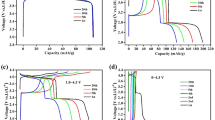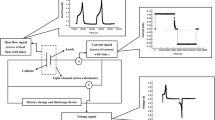Abstract
Safety is important to lithium ion battery materials. The thermal stability of LiFePO4/C-LiMn2O4 blended cathode materials is characterized by using TG, XRD, and SEM etc. The results show that LiFePO4/C-LiMn2O4 possesses a worse thermal stability than pure spinel LiMn2O4 and pure olivine LiFePO4/C. When LiFePO4/C-LiMn2O4 blended cathode materials are sintered at 500°C under Ar atmosphere, the sintered cathode materials emit O2, and appear impurity phases (Li3PO4, Fe2O3, Mn3O4). It is deduced that some chemical reactions take place between different materials, which leads to a worse discharge specific capacity. LiFePO4/C-LiMn2O4 blended cathode materials, therefore, need to be managed and controlled strictly for the sake of thermal stability and safety.
Similar content being viewed by others
References
Ni J F, Zhang L, Fu S D, et al. A review on integrating nano-carbons into polyanion phosphates and silicates for rechargeable lithium batteries. Carbon, 2015, 92: 15–25
Zaghib K, Guerfi A, Hovington P, et al. Review and analysis of nanostructured olivine-based lithium rechargeable batteries: Status and trends. J Power Sources, 2013, 232: 357–369
Antolini E, Ferretti M. Synthesis and thermal stability of LiCoO2. J Solid State Chem, 1995, 117: 1–7
Amatucci G G, Tarascon J M, Klein L C. Cobalt dissolution in LiCoO2-based non-aqueous rechargeable batteries. Solid State Ionics, 1996, 83: 167–173
Dahn J R, Fuller E W, Obrovac M, et al. Thermal stability of LixCoO2, Li x NiO2 and λ−MnO2 and consequences for the safety of Li-ion cells. Solid State Ionics, 1994, 69: 265–270
Tarascon J M, McKinnon W R, Coowar F, et al. Synthesis conditions and oxygen stoichiometry effects on Li insertion into the spinel LiMn2O4. J Electrochem Society, 1994, 141: 1421–1431
Tarascon J M, Coowar F, Amatucci G G, et al. The Li1+x Mn2O4/C system materials and electrochemical aspects. J Power Sources, 1995, 54: 103–108
Kanno R, Kondo A, Yonemura M, et al. The relationships between phases and structures of lithium manganese spinels. J Power Sources, 1999, 81-82: 542–546
Joachin H, Kaun T D, Zaghib K, et al. Electrochemical and thermal studies of carbon-coated LiFePO4 cathode. J Electrochem Society, 2009, 156: A401–A406
Martha S K, Haik O, Zinigrad E, et al. On the thermal stability of olivine cathode materials for lithium-ion batteries. J Electrochem Society, 2011, 158: A1115–A1122
Savut J S, Nurgul S, Shi X Q, et al. Improvement of electrochemical performance of LiNi0.8Co0.1Mn0.1O2 cathode material by graphene nanosheets modification. Electrochim Acta, 2014, 149: 86–93
Xia H, Ragavendran K R, Xie J P, et al. Ultrafine LiMn2O4/carbon nanotube nanocomposite with excellent rate capability and cycling stability for lithium-ion batteries. J Power Sources, 2012, 212: 28–34
Tang X, Savut J S, Qian Y Y, et al. Graphene wrapped ordered LiNi0.5Mn1.5O4 nanorods as promising cathode material for lithiumion batteries. Sci Rep, 2015, 5: 11958
Liu W, Liu J, Chen K F, et al. Enhancing the electrochemical performance of the LiMn2O4 hollow microsphere cathode with a LiNi0.5Mn1.5O4 coated layer. Chem Eur J, 2014, 20: 824–830
Chen K F, Xue D F. Materials chemistry toward electrochemical energy storage. J Mater Chem A, 2016, 4: 7522–7537
Chen K F, Xue D F. Anode performances of mixed LiMn2O4 and carbon black toward lithium-ion battery. Funct Mater Lett, 2014, 7: 1450017
Chikkannanavar S B, Bernardi D M, Liu L Y. A review of blended cathode materials for use in Li-ion batteries. J Power Sources, 2014, 248: 91–100
Yoon W S, Nam K W, Jang D, et al. The kinetic effect on structural behavior of mixed LiMn2O4-LiNi1/3Co1/3Mn1/3O2 cathode materials studied by in situ time-resolved X-ray diffraction technique. Electrochem Commun, 2012, 15: 74–77
Wang S, Wu Y, Li Y, et al. Li[Li0.2Mn0.54Ni0.13Co0.13]O2-LiMn1.5-Ti0.5O4 composite cathodes with improved electrochemical performance for lithium ion batteries. Electrochim Acta, 2014, 133: 100–106
Li X Y, Choe S Y, Joe W T. A reduced order electrochemical and thermal model for a pouch type lithium ion polymer battery with LiNixMnyCo1–x–y O2/LiFePO4 blended cathode. J Power Sources, 2015, 294: 545–555
Author information
Authors and Affiliations
Corresponding author
Rights and permissions
About this article
Cite this article
Du, Y., Huang, X., Zhang, K. et al. Thermal stability of LiFePO4/C-LiMn2O4 blended cathode materials. Sci. China Technol. Sci. 60, 58–64 (2017). https://doi.org/10.1007/s11431-016-0329-7
Received:
Accepted:
Published:
Issue Date:
DOI: https://doi.org/10.1007/s11431-016-0329-7




